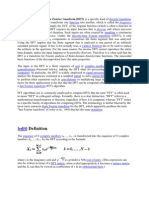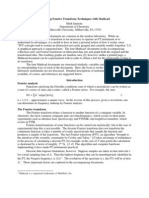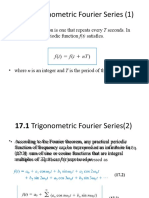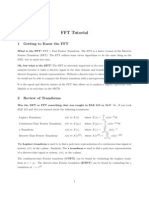DFT Matrix - Wikipedia
DFT Matrix - Wikipedia
Uploaded by
Avani BosanCopyright:
Available Formats
DFT Matrix - Wikipedia
DFT Matrix - Wikipedia
Uploaded by
Avani BosanCopyright
Available Formats
Share this document
Did you find this document useful?
Is this content inappropriate?
Copyright:
Available Formats
DFT Matrix - Wikipedia
DFT Matrix - Wikipedia
Uploaded by
Avani BosanCopyright:
Available Formats
http://en.wikipedia.
org/wiki/DFT_matrix
DFT matrix
From Wikipedia, the free encyclopedia
A DFT matrix is an expression of a discrete Fourier transform (DFT) as a matrix multiplication.
Contents
1 Definition 2 Special cases 3 Examples 3.1 Two-point 3.2 Four-point 3.3 Eight-point 4 Unitary transform 5 Other properties 6 In the limit: The Fourier operator 7 References 8 External links
Definition
An -point DFT is expressed as an -by- matrix multiplication as X = Wx, where x is the original input signal, and X is the DFT of the signal. The transformation W of size can be defined as , or equivalently:
where is a primitive nth root of unity exp( 2i / ). Note that the normalization factor in front of the sum ( ) and the sign of the exponent in are merely conventions, and differ in some treatments. All of the following discussion applies regardless of the convention, with at most minor adjustments. The only important thing is that the forward and inverse transforms have opposite-sign exponents, and that the product of their normalization factors be 1/ . However, the choice here makes the resulting DFT matrix unitary, which is convenient in many circumstances. Fast Fourier Transform algorithms utilise the symmetries of the matrix to reduce the time of multiplying a vector by this matrix, from the usual O( 2). Similar techniques can be applied for multiplications by matrices such as Hadamard matrix and the Walsh matrix.
1 di 4
http://en.wikipedia.org/wiki/DFT_matrix
Special cases
The three-point DFT has a special significance, e.g. as symmetrical components transform (SCT) of Charles Legeyt Fortescue's 1918 paper, that defines three phase balance, i.e. the 3-DFT breaks a signal up into a DC component, as well as two AC components, one going clockwise, and the other going counter clockwise.
Examples
Two-point
The two-point DFT is a simple case, in which the first entry is the DC (sum) and the second entry is the AC (difference).
The first row performs the sum, and the second row performs the difference. The factor of is to make the transform unitary (see below).
Four-point
The four-point DFT matrix is as follows:
Eight-point
The first non-trivial integer power of two case is for 8 points:
where
The following image depicts the DFT as a matrix multiplication, with elements of the matrix depicted by samples of complex exponentials:
2 di 4
http://en.wikipedia.org/wiki/DFT_matrix
The real part (cosine wave) is denoted by a solid line, and the imaginary part (sine wave) by a dashed line. for unitarity), so it "measures" the DC component in the input signal. The The top row is all ones (scaled by next row is eight samples of negative one cycle of a complex exponential, i.e., a signal with a fractional frequency of 1/8, so it "measures" how much "strength" there is at fractional frequency +1/8 in the signal. Recall that a matched filter compares the signal with a time reversed version of whatever we're looking for, so when we're looking for fracfreq. 1/8 we compare with fracfreq. 1/8 so that is why this row is a negative frequency. The next row is negative two cycles of a complex exponential, sampled in eight places, so it has a fractional frequency of 1/4, and thus "measures" the extent to which the signal has a fractional frequency of +1/4. The following summarizes how the 8-point DFT works, row by row, in terms of fractional frequency: 0 measures how much DC is in the signal 1/8 measures how much of the signal has a fractional frequency of +1/8 1/4 measures how much of the signal has a fractional frequency of +1/4 3/8 measures how much of the signal has a fractional frequency of +3/8 1/2 measures how much of the signal has a fractional frequency of +1/2 5/8 measures how much of the signal has a fractional frequency of +5/8 3/4 measures how much of the signal has a fractional frequency of +3/4 7/8 measures how much of the signal has a fractional frequency of +7/8 Equivalently the last row can be said to have a fractional frequency of +1/8 and thus measure how much of the signal has a fractional frequency of 1/8. In this way, it could be said that the top rows of the matrix "measure" positive frequency content in the signal and the bottom rows measure negative frequency component in the signal.
Unitary transform
The DFT is (or can be, through appropriate selection of scaling) a unitary transform, i.e., one that preserves energy. The appropriate choice of scaling to achieve unitarity is , so that the energy in the physical domain will be the same as the energy in the Fourier domain, i.e., to satisfy Parseval's theorem. (Other, non-unitary, scalings, are also commonly used for computational convenience; e.g., the convolution theorem takes on a slightly simpler form with the scaling shown in the discrete Fourier transform article.)
3 di 4
http://en.wikipedia.org/wiki/DFT_matrix
Other properties
For other properties of the DFT matrix, including its eigenvalues, connection to convolutions, applications, and so on, see the discrete Fourier transform article.
In the limit: The Fourier operator
If we make a very large matrix with complex exponentials in the rows (i.e., cosine real parts and sine imaginary parts), and increase the resolution without bound, we approach the kernel of the Fredholm integral equation of the 2nd kind, namely the Fourier operator that defines the continuous Fourier transform. A rectangular portion of this continuous Fourier operator can be displayed as an image, analogous to the DFT matrix, as shown at right, where greyscale pixel value denotes numerical quantity.
References
Real part of Fourier operator
Imaginary part of Fourier operator
The Transform and Data Compression Handbook by P. C. Yip, K. Ramamohan Rao (http://www.amazon.com /gp/reader/0849336929) - See chapter 2 for a treatment of the DFT based largely on the DFT matrix
External links
Fourier Operator and Decimation In Time (DIT) (http://wearcam.org/ece431/course_material /fourierop_and_dit.htm) Retrieved from "http://en.wikipedia.org/wiki/DFT_matrix" Categories: Fourier analysis | Digital signal processing | Matrices This page was last modified on 15 October 2008, at 05:30. All text is available under the terms of the GNU Free Documentation License. (See Copyrights for details.) Wikipedia is a registered trademark of the Wikimedia Foundation, Inc., a U.S. registered 501(c)(3) tax-deductible nonprofit charity.
4 di 4
You might also like
- DSP Solved Question BankDocument19 pagesDSP Solved Question Banksakshi_kapuriaNo ratings yet
- Evaluating Fourier Transforms With MATLABDocument11 pagesEvaluating Fourier Transforms With MATLABAhsan Ratyal100% (1)
- DFT MatrixDocument4 pagesDFT Matrixvolly666No ratings yet
- Frequency Domain Discrete: C À C DFT Finite ! " # $ $ % & " " "Document17 pagesFrequency Domain Discrete: C À C DFT Finite ! " # $ $ % & " " "Ravi Raj DNo ratings yet
- Discrete Fourier TransformDocument12 pagesDiscrete Fourier TransformnaruatNo ratings yet
- Discrete Fourier Transform Fast Fourier Transform Signal ProcessingDocument24 pagesDiscrete Fourier Transform Fast Fourier Transform Signal Processingrathna4indNo ratings yet
- Frequency Domain DiscreteDocument7 pagesFrequency Domain Discreteomprakkash1509No ratings yet
- Notes On Micro Controller and Digital Signal ProcessingDocument70 pagesNotes On Micro Controller and Digital Signal ProcessingDibyajyoti BiswasNo ratings yet
- Discrete-Time Fourier TransformDocument8 pagesDiscrete-Time Fourier Transformbesty666No ratings yet
- Simulating and Analyzing The Fourier Series and Fourier Transform Using Matlab ObjectivesDocument18 pagesSimulating and Analyzing The Fourier Series and Fourier Transform Using Matlab ObjectivesTayyba noreenNo ratings yet
- You Only Live OnceDocument13 pagesYou Only Live OnceSaket AgarwalNo ratings yet
- A Discrete Cosine TransformDocument14 pagesA Discrete Cosine Transformsense89No ratings yet
- FFT BookDocument209 pagesFFT BookVport Port100% (2)
- Fourier NotesDocument4 pagesFourier Notesmrlog1No ratings yet
- The Basics of Digital Signal SpectraDocument14 pagesThe Basics of Digital Signal SpectraAnand Utsav KapoorNo ratings yet
- DFT Computation: Next Previous Fast Fourier Transform Image - Processing Four Forms of FourierDocument6 pagesDFT Computation: Next Previous Fast Fourier Transform Image - Processing Four Forms of Fourierjavabala10No ratings yet
- Fractional Fourier Transform PDFDocument22 pagesFractional Fourier Transform PDFroitnedurpNo ratings yet
- Module 9: Numerical Relaying II: DSP Perspective: Fast Fourier TransformDocument6 pagesModule 9: Numerical Relaying II: DSP Perspective: Fast Fourier Transformmatlab5903No ratings yet
- Simple FFTDocument19 pagesSimple FFTSudeshna KunduNo ratings yet
- Fourier TransformDocument5 pagesFourier Transformrendimulyadi100% (1)
- DFT and FFT: C. Kankelborg Rev. January 28, 2009Document17 pagesDFT and FFT: C. Kankelborg Rev. January 28, 2009Trí NguyễnNo ratings yet
- Time and Frequency Analysis of Discrete-Time SignalsDocument15 pagesTime and Frequency Analysis of Discrete-Time SignalsVinay Krishna VadlamudiNo ratings yet
- HHT FFT DifferencesDocument8 pagesHHT FFT Differencesbubo28No ratings yet
- Discrete Time Fourier Series Properties: Magnitude Spectrum of X (N), and A Plot ofDocument11 pagesDiscrete Time Fourier Series Properties: Magnitude Spectrum of X (N), and A Plot ofSk Umesh UmeshNo ratings yet
- 17.1 Trigonometric Fourier SeriesDocument96 pages17.1 Trigonometric Fourier SeriesMd. Rezwanul IslamNo ratings yet
- Understanding The DFTDocument2 pagesUnderstanding The DFTleonclarobrNo ratings yet
- DFTDocument5 pagesDFTManojChowdaryNo ratings yet
- FFT in MatlabDocument5 pagesFFT in MatlabNguyen Quoc DoanNo ratings yet
- FFT 4Document41 pagesFFT 4Haris SirajNo ratings yet
- EE370 Lab Experiment 01Document6 pagesEE370 Lab Experiment 01Ayman YounisNo ratings yet
- Signals and Systems: DT e T X F XDocument6 pagesSignals and Systems: DT e T X F XBasim BrohiNo ratings yet
- 1974 Fast Convolution Using Fermat Number Transforms With Applications To Digital FilteringDocument11 pages1974 Fast Convolution Using Fermat Number Transforms With Applications To Digital FilteringRajesh BathijaNo ratings yet
- FFT Matlab TutorialDocument6 pagesFFT Matlab Tutorialichwan13No ratings yet
- A Histogram Is A Graphical Representation of The Distribution of Numerical DataDocument16 pagesA Histogram Is A Graphical Representation of The Distribution of Numerical DataArchanaNo ratings yet
- Excel FourierDocument12 pagesExcel FourierChairul HudaNo ratings yet
- Fundamentals of The Discrete Fourier Transform: XF Xte DTDocument8 pagesFundamentals of The Discrete Fourier Transform: XF Xte DTho-faNo ratings yet
- Discrete Sine TransformDocument5 pagesDiscrete Sine Transformtheholyghost5989No ratings yet
- Chapter 16Document37 pagesChapter 16LiNo ratings yet
- Fast Approximate Fourier Transform Via Wavelets TransformDocument10 pagesFast Approximate Fourier Transform Via Wavelets TransformTabassum Nawaz BajwaNo ratings yet
- B.tech-Ee-4th Sem-S& SDocument147 pagesB.tech-Ee-4th Sem-S& SManav RajputNo ratings yet
- FFT Tutorial: 1 Getting To Know The FFTDocument6 pagesFFT Tutorial: 1 Getting To Know The FFTDavid NasaelNo ratings yet
- Lab 3 DSP. Discrete Fourier TransformDocument16 pagesLab 3 DSP. Discrete Fourier TransformTrí TừNo ratings yet
- FFT For ExperimentalistsDocument24 pagesFFT For ExperimentalistsMara FelipeNo ratings yet
- Frequency Domain ProcessingDocument42 pagesFrequency Domain ProcessingInJune YeoNo ratings yet
- L15-23 NotesDocument2 pagesL15-23 NotesitasneemNo ratings yet
- Using MATLAB To Plot The Fourier Transform of A Time FunctionDocument13 pagesUsing MATLAB To Plot The Fourier Transform of A Time Functionanthony zegarra ochoaNo ratings yet
- DSP and Power System ProtectionDocument11 pagesDSP and Power System ProtectionsegamegaNo ratings yet
- Digital Signal Processing Qn.s and AnswersDocument5 pagesDigital Signal Processing Qn.s and AnswerspolikkgateNo ratings yet
- Seismic Data Processing and InterpretationDocument15 pagesSeismic Data Processing and InterpretationmustafaNo ratings yet
- Assignment of Signal and System: Submitted byDocument12 pagesAssignment of Signal and System: Submitted bynaeem444454No ratings yet
- Fourier NotesDocument14 pagesFourier NotesmattomattoNo ratings yet
- Fourier Transform WikiDocument24 pagesFourier Transform Wikibraulio.dantasNo ratings yet
- FFT, Brief IntroductionDocument4 pagesFFT, Brief IntroductionmarahimruNo ratings yet
- Fourier PropertiesDocument14 pagesFourier PropertiesmfchinNo ratings yet
- Analysis and Design of Multicell DC/DC Converters Using Vectorized ModelsFrom EverandAnalysis and Design of Multicell DC/DC Converters Using Vectorized ModelsNo ratings yet
- Fundamentals of Electronics 3: Discrete-time Signals and Systems, and Quantized Level SystemsFrom EverandFundamentals of Electronics 3: Discrete-time Signals and Systems, and Quantized Level SystemsNo ratings yet
- Huynh Khanh Linh - 104993667 - MDA10008 Global Media IndustriesDocument6 pagesHuynh Khanh Linh - 104993667 - MDA10008 Global Media Industrieswww.kelly5b16No ratings yet
- Fitness Tracker ID115Plus HRDocument23 pagesFitness Tracker ID115Plus HRjohndoeNo ratings yet
- Ijet 19085Document5 pagesIjet 19085azrul hussinNo ratings yet
- Watertite TE 40Document2 pagesWatertite TE 40Alexi ALfred H. TagoNo ratings yet
- ICOM IC-R6 Manual (EN)Document96 pagesICOM IC-R6 Manual (EN)Mandu CerianoNo ratings yet
- Probset 1 SolutionsDocument3 pagesProbset 1 SolutionsSuncheon8114No ratings yet
- Ellen Gonzalvo - COMMENTS ON REVISIONDocument3 pagesEllen Gonzalvo - COMMENTS ON REVISIONJhing GonzalvoNo ratings yet
- 1 A Proposed Therapeutic Resort Complex in Siargao Island Developing A Better Healing Environment Through Biophilic DesignDocument276 pages1 A Proposed Therapeutic Resort Complex in Siargao Island Developing A Better Healing Environment Through Biophilic DesignFrancine Joyce AguilaNo ratings yet
- Easily Optimize A Stock Portfolio Using PyPortfolioOpt in Python - by Damian Boh - DataDrivenInvestorDocument25 pagesEasily Optimize A Stock Portfolio Using PyPortfolioOpt in Python - by Damian Boh - DataDrivenInvestorcheeNo ratings yet
- Tscm62 05-Details BooksDocument2 pagesTscm62 05-Details BooksPadma RajuNo ratings yet
- HAAS VF-HS Mill Programming Book 2005Document143 pagesHAAS VF-HS Mill Programming Book 2005Robert HamiltonNo ratings yet
- 1.simple Present Tense HPDocument10 pages1.simple Present Tense HPnia hijriati fahrumNo ratings yet
- Reading Comprehension and Its Relationship To Creative Nonfiction Academic Performance of Grade 12 Vision StudentsDocument15 pagesReading Comprehension and Its Relationship To Creative Nonfiction Academic Performance of Grade 12 Vision StudentsChai ChaiNo ratings yet
- Laboratory Techniques Lab Report: Option One: Density Measurements Virtual LabDocument4 pagesLaboratory Techniques Lab Report: Option One: Density Measurements Virtual LabGloomieNo ratings yet
- Republic of The Philippines Landy National High School Landy, Santa Cruz, MarinduqueDocument2 pagesRepublic of The Philippines Landy National High School Landy, Santa Cruz, MarinduqueVianice Gayle QuezadaNo ratings yet
- 2016-2019 Paper 2 Revision PDFDocument140 pages2016-2019 Paper 2 Revision PDFslap bwoy100% (1)
- SylabusDocument3 pagesSylabusSebastián LlauceNo ratings yet
- Api I C2Document31 pagesApi I C2mihai37No ratings yet
- 165T-5 Parts ListDocument26 pages165T-5 Parts ListJorge Luis Galezo MuñozNo ratings yet
- Lab Report Chemist Chapter 2 (nEW)Document12 pagesLab Report Chemist Chapter 2 (nEW)SPMUSER9A96% (45)
- University-To-Industry Knowledge Transfer: Literature Review and Unanswered QuestionsDocument18 pagesUniversity-To-Industry Knowledge Transfer: Literature Review and Unanswered QuestionsHeriberto AguirreNo ratings yet
- Comments On The FIC Inspection & Testing PlanDocument3 pagesComments On The FIC Inspection & Testing PlanNoor A QasimNo ratings yet
- IRJET Paper-3Document8 pagesIRJET Paper-3Vashishth KushwahaNo ratings yet
- Sample Marking Task 1 AC 6767 Marriage and Divorce RatesDocument12 pagesSample Marking Task 1 AC 6767 Marriage and Divorce RatesYenPhamNo ratings yet
- AHL Unit Removal For Pre 0305Document4 pagesAHL Unit Removal For Pre 0305Alex PioneerNo ratings yet
- Solar Irrigation-Detailed Project Report PDFDocument17 pagesSolar Irrigation-Detailed Project Report PDFJimmy ValentineNo ratings yet
- 1.3 Crystal Faces and Miller IndicesDocument20 pages1.3 Crystal Faces and Miller IndicesTonatiuh ZamaNo ratings yet
- Algae and Environmental Sustainability 2015 PDFDocument194 pagesAlgae and Environmental Sustainability 2015 PDFCoimbra RojasNo ratings yet
- English 5 Quarter 1 Kinds of AdjectivesDocument5 pagesEnglish 5 Quarter 1 Kinds of AdjectivesMarcilyn Amparado CadalinNo ratings yet
- Dbms Lab ManualDocument42 pagesDbms Lab ManualMd.samrat Sam SamNo ratings yet

























































































